一般疑问句,否定句,肯定、否定回答,选择疑问句(新概念)
青少版新概念1A语法重点
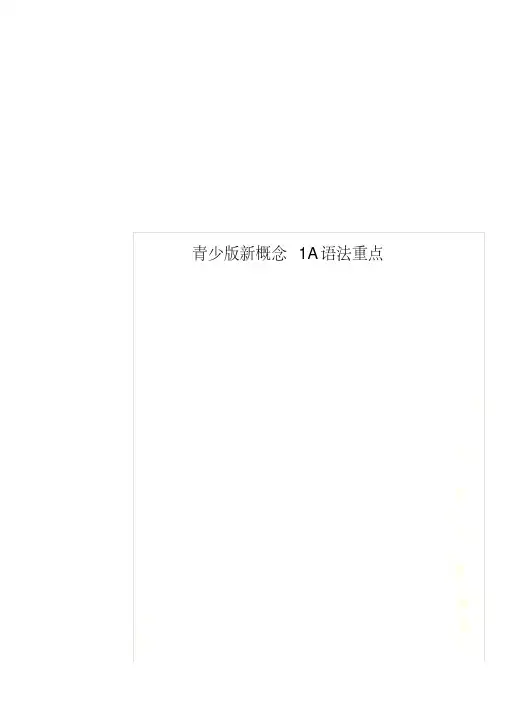
青少版新概念1A语法重点2.肯定句——一般疑问句:①be 提前;②第一人称变第二人称;③句号变问号Is this your pencil?1.肯定句——否定句be(am,is,are)+notThis is not my pencil.Yes, it is. =Yes, it is my pencil.No , it isn ’t. =No, it is not my pencil.肯定句This is my pencil .3.肯定/否定回答Yes,主+be./No,主+ be + not .Unit 1 Meet the family4.Whose 引导的特殊疑问句Whose + be +主?Whose is this pencil? It ’s Lucy ’s.5.介绍自己/别人My name is …/This is …6.正式—How do you do?—How do you do?非正式—Nice to me you.—Nice to me you,too.Unit 2 What is this?1.祈使句定义:用于表达命令,请求,劝告,警告,禁止等的句子叫做祈使句。
Go and wash your hands. (去洗你的手。
——命令)Be quiet, please.(请安静。
——请求)Shut up.(闭嘴。
——警告)Look out!Danger!(小心!危险!——强烈警告,已如感叹句) 2.指示代词汉语意思:这(些),那(些)单数形式:this 这that 那3.缩略形式This is Mary.(这是Mary。
)is not = are not = That is = You are = They are =I’misn’taren’tThat’sYou’re They’reI am =Unit 2 What is this?4. a an 的用法an 用在以元音音素开头的单词前a fish an applea dog an elephanta pig an iguanaa chick an orangea key an umbrella5. What colour/ color 什么颜色对颜色进行提问---What colour is the key? ---It is silver.6.Whose 谁的特殊疑问词对事物所属提问---Whose + be +…? ---… +be + 人名’s. ---Whose is this dress? ---It’s Lucy’s.Unit 3 Who’s that?1.Who 谁特殊疑问词引导特殊疑问句,对人提问---… + be + 人名.---Who + be + …?---Who is he? ---He is Robert.2.Which 哪/那一个对多个中的一个提问---Which is my apple?---The big one.3.介词on/in/withon 在……之上with 有,带着in 在……之内The boy on the silver bicycle is Robert.The woman with the white umbrella is Mrs. Jenkins.The man in the red car is Paul.Unit 3 Who’s that?4.Mr./ Mrs. Jenkins 詹金斯先生/太太Mr.和Mrs. 用在姓之前,不用在名之前5. 人名’s具有两种意义:①缩略形式表示“… 是”是我的女儿。
新概念1-44语法精炼
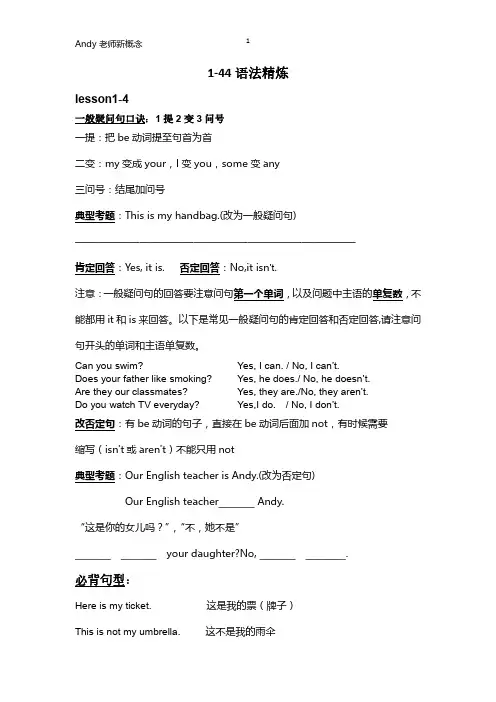
am 只能跟 I 连用
Be
is 单数
are you 或者复数
Andy 老师新概念
4
典型考题:根据示例,写出相应的句子
示例:that man/thin my father/busy
Look at that man. He is very thin. _______________________________________
Andy 老师新概念
1
1-44 语法精炼
lesson1-4
一般疑问句口诀:1 提 2 变 3 问号 一提:把 be 动词提至句首为首
二变:my 变成 your,I 变 you,some 变 any
三问号:结尾加问号
典型考题:This is my handbag.(改为一般疑问句)
——————————————————————————
3
典型考题:Miss Brown is Italian.对画线部分提问) ______ ______ ______ Miss Brown?
Lesson9-10 形容词
描写或修饰名词或代词,表示人或事物的性质、状态、特征、或属性。
目前我们所学的句型中,形容词要跟在 be 后面。如,He is tall.
必背句型:
What’s the matter with you?=What’s wrong with you.你怎么了 These ice creams are nice.这些冰激凌很好吃 Are you all right now? Yes, we are. / No, we aren’t. 你们现在好些了吗?是的,好了。 / 不,还没有。
Lesson11-14 这是谁的...?Whose is this 物品? Whose 物品 is this ? Whose is this shirt? = Whose shirt is this? 这些是谁的...Whose are these 物品复数?Whose 物品复数 are these? Whose are these shirts? = Whose shirt is this?
新概念英语一册一般疑问句知识归纳
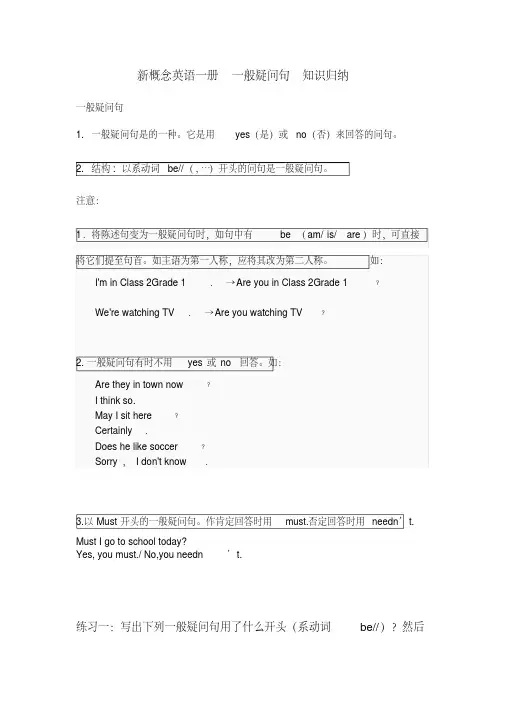
新概念英语一册一般疑问句知识归纳一般疑问句1.一般疑问句是的一种。
它是用yes(是)或no(否)来回答的问句。
2.结构: 以系动词be//(,…)开头的问句是一般疑问句。
注意:1.将陈述句变为一般疑问句时,如句中有be (am/ is/ are)时,可直接将它们提至句首。
如主语为第一人称,应将其改为第二人称。
如:I'm in Class 2Grade 1.→Are you in Class 2Grade 1﹖We're watching TV.→Are you watching TV﹖2.一般疑问句有时不用yes或 no 回答。
如:Are they in town now﹖I think so.May I sit here﹖Certainly.Does he like soccer﹖Sorry, I don't know.3.以Must开头的一般疑问句。
作肯定回答时用must.否定回答时用needn’t.Must I go to school today?Yes, you must./ No,you needn’t.练习一:写出下列一般疑问句用了什么开头(系动词be//)?然后把一般疑问句变为肯定句(陈述句)。
并作出肯定回答和否定回答。
you from Japan﹖her sister doing her homework now﹖he work in a bank﹖you live near your school﹖you speak French﹖I go home now﹖this your suit?Tom climbing the tree?they going to wait for the bus?I go home?练习二:把下列句子改为一般疑问句。
1. lives in the countryside.2.Jim can do his homework by himself.3.My sister often takes me to school in the morning.4.She usually starys at home at night.5.I can see the teapot behind the vase.6.There is some milk in the bottle.7.I am going to paint my bookcase.8.There are some clouds in the sky.9.Hans is German.10.This bedroom is very untidy.11.H e must go to the butcher’s today。
新概念知识点整理
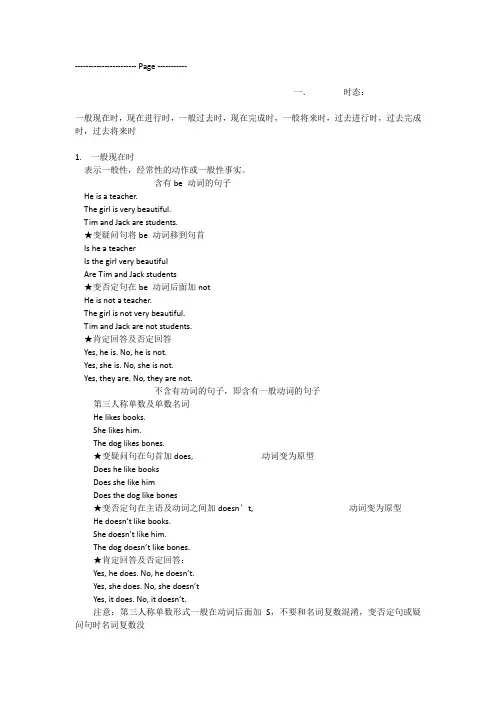
----------------------- Page -----------一.时态:一般现在时,现在进行时,一般过去时,现在完成时,一般将来时,过去进行时,过去完成时,过去将来时1. 一般现在时表示一般性,经常性的动作或一般性事实。
含有be 动词的句子He is a teacher.The girl is very beautiful.Tim and Jack are students.★变疑问句将be 动词移到句首Is he a teacherIs the girl very beautifulAre Tim and Jack students★变否定句在be 动词后面加notHe is not a teacher.The girl is not very beautiful.Tim and Jack are not students.★肯定回答及否定回答Yes, he is. No, he is not.Yes, she is. No, she is not.Yes, they are. No, they are not.不含有动词的句子,即含有一般动词的句子第三人称单数及单数名词He likes books.She likes him.The dog likes bones.★变疑问句在句首加does, 动词变为原型Does he like booksDoes she like himDoes the dog like bones★变否定句在主语及动词之间加doesn’t, 动词变为原型He doesn’t like books.She doesn’t like him.The dog doesn’t lik e bones.★肯定回答及否定回答:Yes, he does. No, he doesn’t.Yes, she does. No, she doesn’tYes, it does. No, it doesn’t.注意:第三人称单数形式一般在动词后面加S,不要和名词复数混淆,变否定句或疑问句时名词复数没有任何变化。
新概念英语一册-1-20复习
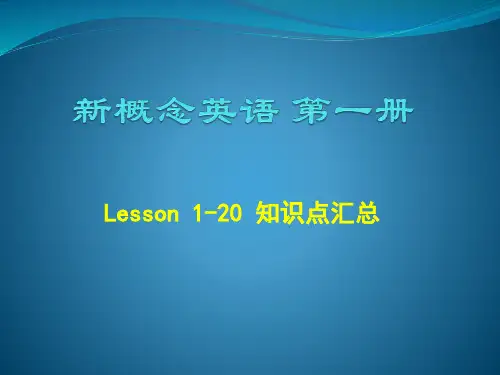
11. do well in = good at
He does well in English = He is good at English
12. See, Look, Watch
see 看的结果
I cannot see anything.
look 看的动作
Look at the blackboard.
e.g. potato→potatoes,hero→heroes, tomato→tomatoes 剩下的加-s, radio→radios 规则4 以f, fe结尾的,变f, fe为ves e.g. life→lives half→halves, shelf→shelves, city→cities, 规则5 以辅音字母+y结尾, 变y为i+es e.g. sky→skies fly→flies
eighty /'eiti/
ninety/'nainti /
21—29Twenty-one/two/three/four/five/six/seven/eight/nine
Ways of expressing numbers 数字的表达(四)
4. hundred是“百”,在表示一个具体的数目时,hundred 后面不能加“-s”。 三位数的表达: 如:101 one hundred and one 148 one hundred and forty-eight 256 two hundred and fifty-six
16. hard-working adj. 勤奋的 Lucy is a hard-working employee. hard-work n. 艰苦的工作 This is a hard-work. work hard 努力地工作 We work hard. 我们努力地工作。
新概念英语第一册重点词汇和语法(完整版)
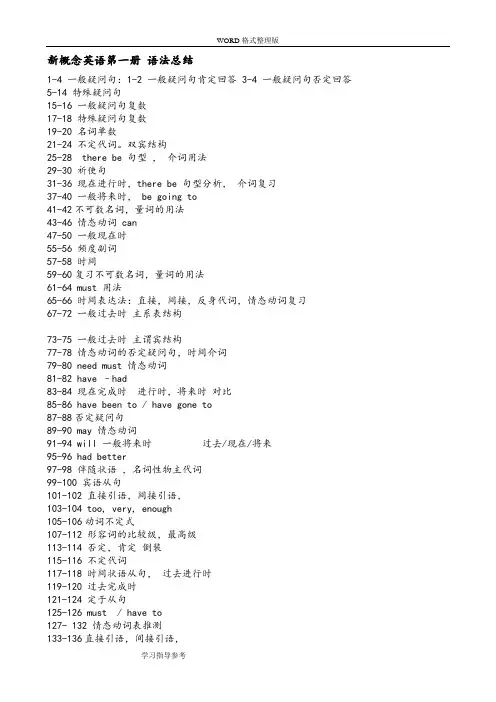
新概念英语第一册语法总结1-4 一般疑问句:1-2 一般疑问句肯定回答 3-4 一般疑问句否定回答5-14 特殊疑问句15-16 一般疑问句复数17-18 特殊疑问句复数19-20 名词单数21-24 不定代词。
双宾结构25-28 there be 句型,介词用法29-30 祈使句31-36 现在进行时,there be 句型分析,介词复习37-40 一般将来时, be going to41-42不可数名词,量词的用法43-46 情态动词 can47-50 一般现在时55-56 频度副词57-58 时间59-60复习不可数名词,量词的用法61-64 must 用法65-66 时间表达法:直接,间接,反身代词,情态动词复习67-72 一般过去时主系表结构73-75 一般过去时主谓宾结构77-78 情态动词的否定疑问句,时间介词79-80 need must 情态动词81-82 have –had83-84 现在完成时进行时,将来时对比85-86 have been to / have gone to87-88否定疑问句89-90 may 情态动词91-94 will 一般将来时过去/现在/将来95-96 had better97-98 伴随状语,名词性物主代词99-100 宾语从句101-102 直接引语,间接引语,103-104 too, very, enough105-106动词不定式107-112 形容词的比较级,最高级113-114 否定,肯定倒装115-116 不定代词117-118 时间状语从句,过去进行时119-120 过去完成时121-124 定于从句125-126 must / have to127- 132 情态动词表推测133-136直接引语,间接引语,137-138 条件状语从句139-140宾语从句141-144 被动语态Lesson 1 Excuse me1. Words1) excuse (1)重音(2)与sorry 的区别(3)Excuse 用的不同场景a. 请别人让路b. 引起别人的注意c. 打断别人的谈话d. 可以当n. 借口 eg. No excuse. 别找借口,没有借口。
新概念英语第一册Lesson
Lesson 39 Don’t drop it! 别摔了!What are going to do with that vase, Penny? 你打算如何处理那花瓶,彭妮?do with sth.处理某物1. 你要如何处理那只狗,妈妈?______________________________________________________________I am going to put it on the table, Sam.我打算把它放在桌子上,Sam.put --- on---把某物放在---上1. 把书放在书桌上______________________________________________________把饭放在餐桌上______________________________________________________2. 我要把那本书放在书桌上。
_________________________________________________________我要把狗狗放在我的床上。
_____________________________________________________________我要把狗狗放在我的床下。
________________________________________________________我要把我的狗狗放在爸爸和妈妈之间。
________________________________________________________Don’t do that. Give it to me.不要做那个(不要放在那儿)。
把它给我。
give sth. to sb. = give sb. sth. 把某物给某人1. 我把书给了张馨元。
__________________________________________________________________________________________________________2. 不要把书给张馨元。
主谓宾-助动词,否定句,一般疑问句
(分析主语主格)中译英
$
• 5. 我没有字典。 • • • • •
•
主格:I, 一单 我 没有 字典。 主 谓 宾 否定句:主--谓--宾 I don't have (a) dictionary.
主 谓 宾
(分析主语主格)中译英
$
• 6. 她帮助她的妈妈。 • • • • •
•
主格:she, 三单 她 不帮助 (她的)妈妈。 主 谓 宾 否定句:主--谓--宾 She doesn't help (her) mother.
一般疑问句
$
• • • • • • • • •
将下列句子改成一般疑问句。 5. 我的爸爸想要一栋新房子。 一般疑问句:你的爸爸想要一栋新房子吗? 主:(your) father=he,三单 谓:does...want 宾:(a new )house Does your father want a new house ? Yes, he does. No, he doesn't.
口语--like • 我喜欢狗,但我妈妈不喜欢。
$
• I like dogs, but my mother doesn't.
• 我的妹妹喜欢仓鼠,但我不喜欢。
• My little sister likes hamsters, but I don't.
• Linda喜欢蛇,但她的朋友们不喜欢。
• Linda likes snakes, but her friends don't.
• 2. Sophie______(like) hamsters very much.
• 3. Linda and I _____(have) a nice car.
新概念英语第一册每课知识点1-38课(汇编)
新概念英语第一册每课知识点Lesson1-2 Excuse me! 对不起!Is this your…?这是你的…吗?语言点:与陌生人说话或引起别人的注意。
Excuse me.译成汉语:劳驾或打扰一下。
Yes?什么事?Yes. 是的。
Pardon?请再说一遍。
Thank you very much.非常感谢。
语法点:主系表结构this为主语,名词做表语一般疑问句以及它的肯定回答。
Is this your handbag? Yes, it is.Lesson 3-4 Sorry, sir. 对不起,先生。
Is this your…?这是你的…吗?语言点:询问某物是某人的吗语法点:简单的否定句。
It isn’t my coat.一般疑问句的否定形式Is this your umbrella?—Is this not your umbrella?Is this your ticket?---Is this not your ticket? (回答时要根据事实来回答)Lesson 5-6 Nice to meet you。
很高兴见到你。
What make is it? 它是什么牌子的?语言点:如何介绍别人。
This is Miss Sophie Dupont. Nice to meet you.询问物品的牌子:What make is +单数可数名词?语法点:主语为第三人称单数的主系表结构。
She is French. He is German. It’s a V olvo.(L6)a/an 的使用。
选择疑问句---一般选择疑问句和特殊选择疑问句Lesson 7-8 Are you a teacher? 你是教师吗?What’s your job?你是做什么工作的?语言点:如何自我介绍和相互认识。
询问职业的表达法。
What’s your job?询问国籍的表达法。
What nationality are you?语法点:主语为第二人称的主系表结构。
沪教版三年级上册英语-知识点(否定句、一般疑问句、肯定句、缩写、复数、划线部分提问)
牛津上海版三年级上册英语知识点第1讲改否定句【知识点】1、句子中有am/is/are/can时,直接在后面加not,其他不变,抄下来;2、句子中没有am/is/are/can时,找到动词,在动词前面加don’t/doesn't,其他不变,抄下来。
【练习题】1、I am Mike.否定句:____________________________________________________2、This is a pen.否定句:____________________________________________________3、You are a boy。
否定句:____________________________________________________4、They can swim。
否定句:____________________________________________________5、I like apples.否定句:____________________________________________________6、I am Danny.否定句:____________________________________________________7、This is my ruler。
否定句:____________________________________________________8、Those are his robots.否定句:____________________________________________________9、You can go to have a look.否定句:____________________________________________________10、I know his name.否定句:____________________________________________________11、I am a student.否定句:____________________________________________________牛津上海版三年级上册英语知识点12、It is an apple.否定句:____________________________________________________13、They are my books。
- 1、下载文档前请自行甄别文档内容的完整性,平台不提供额外的编辑、内容补充、找答案等附加服务。
- 2、"仅部分预览"的文档,不可在线预览部分如存在完整性等问题,可反馈申请退款(可完整预览的文档不适用该条件!)。
- 3、如文档侵犯您的权益,请联系客服反馈,我们会尽快为您处理(人工客服工作时间:9:00-18:30)。
一、一般疑问句
1.做题步骤:
1)找be动词(am/is/are)或情态动词(can/must/should...),将be动词或情态动词提前,首字母大写。
4)句尾加“?”
2. 习题
1)He is tall and thin.
________________________________________
2)These are small cats.
________________________________________
3)Peter is ten years old.
________________________________________
4)My friends are playing football.
_____________________________________________
5)They are giraffes.
________________________________________
6)I am Alice.
________________________________________
7)Our teacher is Miss Fang.
________________________________________
8)Her name is Kitty.
________________________________________
9)My sister can skip a rope.
________________________________________
10)We can sing and dance.
________________________________________
11)There are some tigers in the zoo.
________________________________________
二、一般疑问句的肯定回答/否定回答
1. 主语一致
1) Is he Tom?2) Are they good friends?3) Is it a panda?
___________________ _____________________ ______________________ ___________________ _____________________ ______________________
4) Is your sister a pupil? 5) Are Danny and Kitty friends? 6)Is the desk clean?
___________________ _____________________ ______________________ ___________________ _____________________ ______________________
注意①:问句用you,回答改用I或We
1) Are you Jack?2) Are you Chinese?3) Are you policemen?
___________________ _____________________ ______________________ ___________________ _____________________ ______________________
注意②:问句用指示代词this/that或these/those,回答改用it或they(不管是人还是物) 1) Is this your T-shirt?2) Are those your coats? 3) Is that a dress?
___________________ _____________________ ______________________ ___________________ _____________________ ______________________
4) Is that your son? 5) Are these your toys? 6) Is this your daughter?
___________________ _____________________ ______________________ ___________________ _____________________ ______________________
注意 :若问句中this/that或these/those为限定词,则主语一致
1) Is that man your father? 2) Are these peaches pink? 3) Is this girl your daughter? ___________________ _____________________ ______________________ ___________________ _____________________ ______________________
三、否定句
1.做题步骤
1)在be动词后加not。
如:is not=isn’t,are not=aren’t,am not;2)在情态动词can后加not。
如:can not=can’t;
3)some→any
2. 习题
1)This is my book.
____________________________________
2)The girl is a pupil.
____________________________________
3)I am Sophie.
____________________________________
4)Kitty and I are classmates.
____________________________________
5)That is a postman.
____________________________________
6)They are engineers.
____________________________________
7)The sky is blue.
____________________________________
8)We are Japanese.
____________________________________
9) Is the flower red?
____________________________________
10) She is a housewife.
____________________________________
四、选择疑问句
1. 一般疑问句+or+选择部分
注意:选择疑问句回答时不能用yes或no,要求对方选择一种情况回答。
例:She is a doctor. She is a nurse.
Is she a doctor or a nurse?
2. 习题
1)This is a pen. This is a pencil.
___________________________________________
2)He is a postman. He is a policeman.
___________________________________________
3)They are tall. They are short.
___________________________________________
4)That is a hairdresser. That is an airhostess.
___________________________________________
5)These pens are purple. These pens are pink.
___________________________________________
(用“am, is, are”适当形式填空)
1. I ______ a boy. I can run and swim fast. ______ I super?
2. How ______ you? I ______ very well, thanks.
3. What ______ your name? My name ______ Kate.
4. The fat man ______ happy. There ______ many sweets in his hand.
5. How old ______ she? She ______ ten years old.
6. How old _______ you, Peter? I _______ nine.
7. How old ______ your friend? He ________ twelve.
8. Kitty and Linda ________in the classroom.
9. ________ your mother tall? No, she _________.
10. Here _______ your cake. Thanks.。
